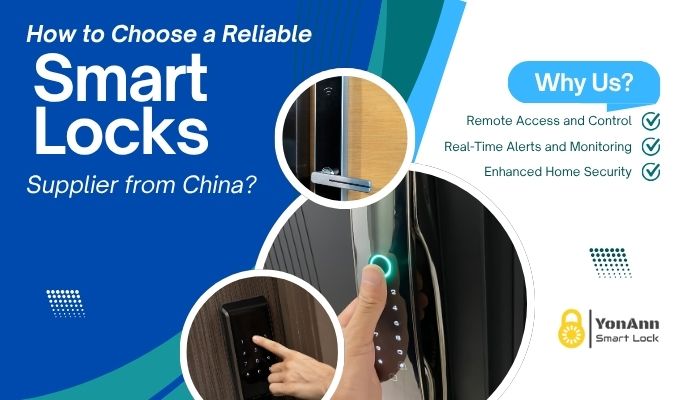
As the global demand for smart locks rises, more distributors and engineering project buyers are turning to China for cost-effective and technologically advanced solutions. Provinces like Zhejiang and Guangdong have become hubs for smart lock production, with thousands of suppliers offering everything from entry-level models to high-end biometric locks.
But with such a large number of suppliers, how do you find the right one—a partner who offers a competitive price without compromising on quality, stability, or innovation?
This guide will walk you through both strategic selection criteria and technical checkpoints to ensure you choose a high-value smart door lock supplier for wholesale or engineering projects.
Section 1: Strategic Selection Tips for Overseas Buyers
1. Define Your Application and Project Requirements
Before contacting suppliers, clarify:
-
What’s the usage: residential, apartment, hotel, office, gym lockers, etc.?
-
Door material: wood, steel, glass, or cabinet?
-
Lock type: card lock, fingerprint lock, face recognition lock, Wi-Fi/Bluetooth-enabled, Tuya smart lock, wifi remote smart lock, camera smart lock, or smart lock for front door, waterproof sliding smart lock?
-
Platform requirements: TTLock, Tuya, Matter, LoRa?
-
Do you need OEM branding or software integration?
This helps filter out unfit suppliers quickly.
2. Check Factory and Supplier Credentials
Ask these questions:
-
Are they ISO-certified? Do they hold CE, FCC, RoHS certificates?
-
Do they have patents or R&D capabilities?
-
Can they provide a factory video tour or quality inspection report?
-
Do they support OEM/ODM for long-term cooperation?
A professional supplier will have clear documentation and transparent communication.
3. Evaluate Communication and Support
Professional suppliers:
-
Offer fast, clear responses in English
-
Provide full documentation: catalogs, datasheets, wiring diagrams
-
Support you with engineering advice and remote assistance
-
Understand international trade terms and compliance standards
Poor communication is a red flag—it will cause delays during mass production or after-sales service.
Section 2: Technical & Quality Evaluation — What Truly Matters

Many suppliers in China offer low-priced smart locks, but low price often equals low quality. To avoid costly mistakes, focus your technical evaluation on these 3 critical areas:
-
Inspect the Three Core Components
A smart lock’s performance depends heavily on these three parts:
🔹 Electronic Mainboard
-
Should use stable, well-designed PCBs
-
Check for organized soldering, protective coatings, and chipset origin
-
Failure here leads to system crashes or battery drainage
🔹 Battery Module
-
High-quality lithium or alkaline batteries are key for outdoor and project use
-
Ask if they use branded batteries with power management ICs
-
Poor batteries cause voltage drops and unlock failures
🔹 Motor System
-
Choose metal gear motors over plastic ones
-
Must withstand frequent usage without overheating or stalling
-
Ask about torque performance and endurance cycle testing
💡 Tip: Open a sample and verify components by visual inspection or a third-party lab report.
-
Examine the Smart Technology – Especially for Biometric Locks
If your project requires advanced features like face recognition, pay close attention to:
🔹 Face Recognition Module
-
Must use an independent camera for accurate facial detection
-
Integrated sensors or cheap cameras perform poorly under variable lighting
🔹 Outdoor Performance
-
Face recognition should work in low light (dark hallways) and high exposure (direct sunlight)
🔹 Housing Material & Fire Safety
-
Always choose locks with metal casings
-
Any plastic components (e.g., internal housings) should be flame-retardant (UL94‑V0 or similar)
-
Metal shells improve durability and heat resistance
-
Confirm Environmental Protection – “Three-Proof” Design
Over 90% of smart lock failures are caused by moisture, heat, or freezing issues—especially in humid regions or outdoor installations.
🔹 Moisture Protection
-
Ask if the mainboard has conformal coating or waterproof sealing
-
Locks without this are prone to condensation and short-circuits
🔹 UV Resistance
-
Essential for outdoor locks exposed to strong sunlight
-
Prevents discoloration and plastic degradation
🔹 Freeze Resistance
-
Lock electronics should work at temperatures down to -20°C or lower
-
Essential for markets in cold regions or mountain areas
Section 3: Supplier Testing Tips Before Bulk Order
Here’s how to reduce risk:
| Checklist Item | Why It Matters |
| Request 2–3 lock samples | Test quality, stability, and app connectivity |
| Do a humidity box test | See if condensation affects electronics |
| Test the camera under sunlight and in darkness | Ensure face unlock works in real-world scenarios |
| Try a full installation with accessories | Check manual clarity, screw size, and packaging |
Why YonAnn Lock is a Smart Choice for Overseas Buyers

At YonAnn, we aim to offer not just competitive pricing—but intelligent value:
✅ 15+ years in the smart lock industry
✅ Exported to 50+ countries (Middle East, India, Africa, Southeast Asia, etc.)
✅ CE, FCC, RoHS certified
✅ OEM/ODM customization available
✅ “Three-proof” designs and industrial-grade components
✅ English-speaking tech support team
👉 Visit us: www.yonannlock.com
📧 Email: info@yonannlock.com
Conclusion
With thousands of smart lock suppliers in China, finding the right one requires more than chasing low prices. You need a manufacturer that understands your market, offers durable and reliable products, and supports you like a long-term partner.
Focus on:
-
Verified core components
-
Robust smart tech and design
-
Reliable “three-proof” protection
By combining smart strategy with deep technical checks, you can confidently source the best smart locks from China—ones that satisfy your customers and support your business growth.
